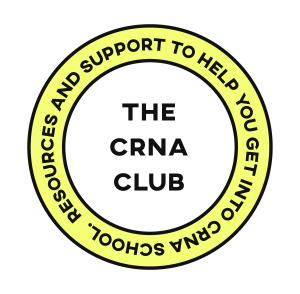So you've decided that you want to become a CRNA. Congratulations! That’s a massive first step.
So what’s next?
You sit down at your computer open up the almighty Google and type in the words “Top CRNA Programs”.
Immediately, you're overwhelmed with a wealth of information and terms you don't quite understand.
Attrition rate? NCE? What the heck does “matriculation” mean?
Take a deep breath. You're not alone, we've all been there. Your mind is buzzing with questions.
Today, let’s talk about 10 things (and a bonus) that you need to look at when picking a CRNA school.
1. DNP vs DNAP
All CRNA programs are Doctorate Degrees as of 2022. That means at a minimum, programs are 36 months long. Generally speaking, there are two types of degrees, a DNP (Doctorate of Nursing Practice) and a DNAP (Doctorate of Nurse Anesthesia Practice).
What’s the difference?
The DNP versus the DNAP mainly has to do with the accreditation of the anesthesia program. If the anesthesia program is tied to the school of nursing for accreditation, then the degree offered will be a DNP. If the program is only accredited by the COA, and therefore not tied to a nursing program, they will offer a DNAP degree.
Is there a difference in the amount of anesthesia education offered?
No. Both DNP and DNAP prepared CRNAs will receive the same “level” of anesthesia knowledge. They will both sit for the same National Certification Exam (NCE) to become a CRNA.
One caveat is, the DNAP is not widely recognized as a terminal nursing degree (by nursing programs). What does this mean? Some nursing programs may not accept the DNAP as a degree to teach nursing students. Now, this is not the case for CRNA programs, if you have a DNAP, you’ll be able to teach CRNA students. I’m talking about general ADN or BSN students.
If you want to teach nursing students, a DNP will be recognized as a terminal degree and you will have no problem working as a nursing instructor.
2. Integrated vs. Front-Loaded
In short, integrated programs run their didactic and clinical portions together. Typically schools try to match up the classroom topic with the clinical experience. You'll learn about Pediatrics in class and then attend your Pediatrics rotation at the same time. With a front-loaded program the first year or so of your anesthesia schooling will be spent in the classroom the second half of your CRNA program will be spent in clinicals. Basically, it comes down to what kind of learner you are. Do you prefer to be more Hands-on and learn as you go? Or are you the type of person who likes to be prepared and know everything before walking into a new clinical scenario? Both students will get to the same destination, the road to get there is just different.
3. Hybrid Program
With all of the program's now being Doctorate Degrees, students are expected to do a research project. Some schools do this as a group project, others do this individually. Some programs have adopted a hybrid format where the first few months of the program are done entirely online and students can remain where they are, location wise. Many programs put the research portion of the project up front. This allows students to continue to work and live where they are for the first few months of the program, without disrupting their lives and having to move and quit their jobs. Programs understand that 3 years is a long time to not have any income, so some have adopted this hybrid format in order to ease the financial burden, and life disruption.
4. Class Size
Of course a smaller class size means more individualized attention, and hopefully support. With a smaller class size your professors really get to know you and your personality and they are able to help you get the clinical experiences you are lacking, or looking for. Many CRNA programs are about 20 to 30 students. Some a little more some a little less. There are however some programs that accept up to 50 or 55 students. This is on the higher and bigger range for CRNA programs. It's a personal preference, but many students prefer a smaller class size.
5. Attrition Rate
Attrition rate is basically the percentage of students that do not continue on after the first year. People consider this the fail out rate. Anything above 10% deserves a closer look, and you want to start asking yourself why are students not continuing on? Is it just the class size is really small, therefore if one person drops out the attrition rate seems high? Or are their students not being supported?
6. First Time NCE Pass Rate
The national certification exam AKA “boards” is the grand finale at the end of graduation. Look at a school's first time NCE pass rate posted on their website. To keep their accreditation they schools need to maintain an 80% or above.
7. GPA Calculation
Anesthesia schools calculate their GPAs in a couple of different ways. They look at the cumulative or overall GPA, the science GPA, nursing GPA, or the last 60 credits. Depending on if you have multiple degrees, or if you slacked off at the beginning of your college career, there are a couple of different strategies regarding what type of GPA calculation best serves you.
For example if you're one of those people who had a lot of fun your first two years of college, but you got it together the last two years when you were in your nursing program, it might be in your best interest to apply to schools that calculate your GPA based on your last 60 credits.
8. GRE Requirement
Schools seem to be removing the GRE requirement, but many CRNA programs still require it. There are quite a few schools that will waive the GRE requirement as long as you achieved a certain GPA. You can use our school database to figure out what CRNA programs have waived the GRE requirement, or what the minimum required scores are. It seems a lot of programs require at least a 297 or 300. We recommend aiming for a 305-310 to be competitive.
9. Critical Care Experience
Traditionally, we think of CRNA schools only accepting adult ICU experience. But actually, that's not the case. Did you know there are a handful of schools that accept flight nursing to get into CNA school? Yup, we have that in our CRNA school database, too!
NICU and PICU nursing are accepted by quite a few schools. ER, Burn ICU, and CCU are also accepted on a case by case basis.
What does it come down to?
Basically, if you can prove that you are caring for high-acuity patients, with invasive lines on vasopressors, and mechanically ventilated, you will likely meet the critical care requirement. Some schools are very strict on what units do or do not meet this criteria. Other programs are a little more vague, and state that multiple areas of critical care will be accepted, given that the applicant can clearly demonstrate their experience in the aforementioned areas. Aka, “on a case by case” basis.
Don’t forget, always email your programs to double check if they accept your experience type if you have any question!
10. Pre-requisites
One of the biggest things that holds people back from applying to certain schools, is that they do not meet the prerequisite requirement. Some programs require organic or biochemistry (usually programs will accept either of those interchangeably, not both), statistics, or physics for example.
Taking extra science classes will take at a minimum 3 months. That deters a lot of students from applying to certain programs. Do you want to know which programs you already meet the requirements for? Use our school database to search CRNA programs by prerequisites required!
Bonus Tip: Clinical Sites
When you are in CRNA School you are going to have to rotate to multiple clinical sites. The amount of different clinical sites you have to rotate to, will vary program by program. Some students are at a new clinical site every month, while others have a primary clinical site where they stay at for the majority of their training, and rotate out for specialty experiences (pediatrics, OB, regional are a few).
Are you expected to pay for accommodations when you rotate to out of state or out of city clinical sites? It varies. Some programs expect you to find your own accommodations, others will have places set up for you to stay. Depending on how often you have to rotate out, this can be incredibly stressful!
Typically programs will list what clinical sites students rotate to, on their website. Just because a school has 30 or more clinical sites, doesn't mean that students rotate to all of them. Attending an open house or an online webinar for your prospective CRNA schools is a great idea and many programs offer these, so check their websites. Oh, also check their FAQ’s page!
Overall, picking the CRNA schools that you want to apply to is a pretty big freaking deal. You can spend well over 10 hours searching through websites, requirements, and scrounging for information.
The good news?
We have created a CRNA School database that has every single CRNA program as well as details on class size, type of specialty experience requested, how many years of critical-care is required before you apply, integrated vs front-loaded, scholarships available, and so much more!
We have saved applicants hours and hours of searching, and using our school database, applicants have been able to narrow down the schools that are a right fit for them in a matter of a few hours.
Good luck!


